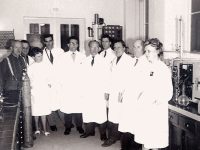
The professional rise of surgery in the eighteenth century may not be understood without the Napoleonic wars, nor the growth of atomic physics at the beginning of the twentieth century without the world wars, nor the aerospace industry without the Cold War. Rivalry and the exceptional nature of war lay the ground for a boost in techno-science as an instrument to overpower the adversary. Even beyond ethical frontiers, as emphasised by Nazi Germany. Military innovations have applications in time of peace, as shown in the expansion of health industries since World War II, true turning point for healthcare technology. Antibiotics, analgesics, antipyretics, or vitamins are examples of it. Health industries turned hospital space into the stage for a technological revolution.
During both world wars, experiments were made with ultrasounds. The sonar and radar were used to detect enemy planes. At the end of the war, specialties such as radiology, urology, neurology, ophthalmology, or gynecology would benefit from new technologies. At the University of Glasgow experiments began to apply ultrasound for obstetrics in order to prevent x-rays ionising radiation and risks of malformations in the fetus. In 1972, the first ultrascope was marketed, and its use spread for examinations during pregnancy.
The first laser with medical applications was manufactured in 1960. Ophthalmologists applied it to retinal detachment, improving the uncertain results of photocoagulation. The therapeutic possibilities of laser technologies aroused the interest of the Columbia Presbyterian Medical Center and the Optics Technology group from Stanford University, who introduced upgrades in the new argon apparatus, which spread its use for surgery, otolaryngology, and gastroenterology.
«Health industries turned hospital space into the stage for a technological revolution»
Between 1940 and 1970 health technology modified the industrial structure that supported it, concentrating it in a few large companies. The invention of the CT scanner marked a turning point. It was born from the idea to connect particle physics and electronics. The first steps were taken at the end of the 1960s. Godfrey Hounsfield convinced record label EMI – the publishers of the Beatles – to build the CT scanner. The first scanners were used to observe the inside of the skull. Commercial impact was so brutal that small industries had to abandon against the power of big business.
In the 1970s the way had only started. Microelectronics and the development of biocompatible materials started a new spectacular line that would impact traumatology, orthopedics, surgery, transplants and other fields greatly. Cooperation between surgery and engineering began when Medtronic was commissioned by a group of surgeons from Minnesota to create a small generator powered by a battery to be used in child cardiac surgery procedures. Medtronic soon became the world’s largest pacemaker manufacturer.
We could provide similar examples relating to the use of nuclear energy and aeronautics, showing that war encourages technological innovation. But we must not forget that war also has negative consequences for science. It destroys scientific communities, as in 1939 in Spain, when a country that was scientifically and technologically integrated in the international community was ruined by exile, or in the powerful Germany after the Jewish exile and holocaust. In addition, in medicine, the technological revolution has devalued the human dimension of the patient because the doctor-patient relationship is now subordinated to technology. Always expensive technology that generates inequalities, which leads us to a different debate.





